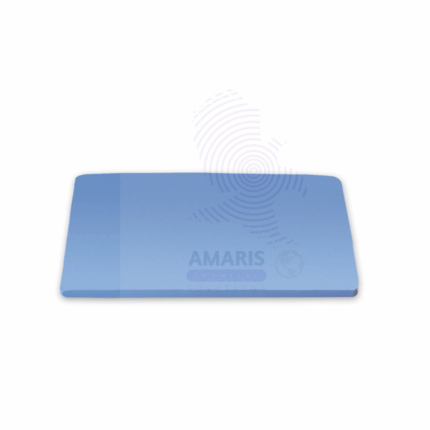

Dissecting Board / Soft Board
Dissecting Board, also known as Soft Board, is a laboratory accessory designed to provide a stable and cushioned surface for securing biological specimens during dissection procedures. Typically made from soft, durable materials like foam or rubber, the board allows easy pinning of specimens without causing damage or slippage. It is widely used in medical, veterinary, educational, and research laboratories for anatomical studies, surgical training, and sample preparation. The soft texture enhances precision and control, facilitating effective specimen manipulation and minimizing tissue trauma.
Uses
Primary Uses
Medical and Biological Dissection
- Stabilizing and positioning specimens by pinning during dissections and anatomical studies.
- Providing a safe, cushioned surface to reduce damage to delicate tissues.
- Supporting surgical training by allowing repeated specimen fixation and manipulation.
- Facilitating clear visualization and access to anatomical structures during dissections.
- Used in veterinary dissection labs for sample preparation and examination.
Secondary Uses
Research and Educational Laboratories
- Assisting botanical, entomological, and zoological dissections requiring stable specimen mounting.
- Supporting forensic specimen preparation and detailed examination.
- Enhancing specimen handling during histological and pathological sample processing.
- Serving as a reusable, easy-to-clean platform for multiple dissection sessions.
- Useful in comparative anatomy research and teaching demonstrations.
Basic Identification Attributes
- Material: Soft foam, rubber, or similar pliable, pin-friendly material
- Size: Available in various sizes to accommodate different specimen dimensions
- Surface: Non-toxic, durable, and easy to clean
Physical & Chemical Properties
- Flexible yet firm enough to hold pins securely during dissection
- Resistant to chemicals and biological reagents commonly used in laboratories
- Reusable and easy to disinfect for hygienic use
Safety & Hazard Attributes
- Non-toxic and safe for handling with standard laboratory precautions
- Reduced risk of injury compared to hard dissecting surfaces
- Requires regular cleaning to prevent microbial contamination
Storage & Handling Attributes
- Store in a clean, dry environment away from direct sunlight and harsh chemicals
- Clean with mild disinfectants or laboratory-approved detergents after use
- Inspect periodically for wear or damage affecting pin retention
Regulatory & Compliance Attributes
- Manufactured according to laboratory safety and quality standards
- Suitable for use in clinical, veterinary, educational, and research laboratories
Environmental & Health Impact
- Often made from recyclable or biodegradable materials depending on type
- Promotes environmentally responsible laboratory practices through reusability
- Dispose of responsibly at end of service life
Safety Handling Precautions
- Use gloves when handling specimens and cleaning the board
- Avoid sharp objects except dissection pins to maintain board integrity
- Follow recommended cleaning and sterilization protocols
First Aid Measures
- Minimal risk; wash skin if irritation occurs from cleaning agents
- Clean pin punctures promptly and seek medical attention if needed
Firefighting Measures
- Generally non-flammable; avoid exposure to open flames
- Use suitable extinguishing agents if combustion occurs


 Preservatives(food)
Preservatives(food) Flavor Enhancers
Flavor Enhancers Acidulants
Acidulants Sweeteners
Sweeteners Antioxidants
Antioxidants Colorants(food)
Colorants(food) Nutraceutical Ingredients (food)
Nutraceutical Ingredients (food) Nutrient Supplements
Nutrient Supplements Emulsifiers
Emulsifiers
 Collectors
Collectors Dust Suppressants
Dust Suppressants Explosives and Blasting Agents
Explosives and Blasting Agents Flocculants and Coagulants
Flocculants and Coagulants Frothers
Frothers Leaching Agents
Leaching Agents pH Modifiers
pH Modifiers Precious Metal Extraction Agents
Precious Metal Extraction Agents
 Antioxidants(plastic)
Antioxidants(plastic) Colorants (Pigments, Dyes)
Colorants (Pigments, Dyes) Fillers and Reinforcements
Fillers and Reinforcements Flame Retardants
Flame Retardants Monomers
Monomers Plasticizers
Plasticizers Polymerization Initiators
Polymerization Initiators Stabilizers (UV, Heat)
Stabilizers (UV, Heat)
 Antifoaming Agents
Antifoaming Agents Chelating Agents
Chelating Agents Coagulants and Flocculants
Coagulants and Flocculants Corrosion Inhibitors
Corrosion Inhibitors Disinfectants and Biocides
Disinfectants and Biocides Oxidizing Agents
Oxidizing Agents pH Adjusters
pH Adjusters Scale Inhibitors( water)
Scale Inhibitors( water)
 Antioxidants(cosmetic)
Antioxidants(cosmetic) Emollients
Emollients Fragrances and Essential Oils
Fragrances and Essential Oils Humectants
Humectants Preservatives
Preservatives Surfactants(cosmetic)
Surfactants(cosmetic) Thickeners
Thickeners UV Filters
UV Filters
 Fertilizers
Fertilizers Soil Conditioners
Soil Conditioners Plant Growth Regulators
Plant Growth Regulators Animal Feed Additives
Animal Feed Additives Biostimulants
Biostimulants Pesticides (Herbicides, Insecticides, Fungicides)
Pesticides (Herbicides, Insecticides, Fungicides)
 Active Pharmaceutical Ingredients (APIs)
Active Pharmaceutical Ingredients (APIs) Excipients
Excipients Solvents(pharmaceutical)
Solvents(pharmaceutical) Antibiotics
Antibiotics Antiseptics and Disinfectants
Antiseptics and Disinfectants Vaccine Adjuvants
Vaccine Adjuvants Nutraceutical Ingredients (pharmaceutical)
Nutraceutical Ingredients (pharmaceutical) Analgesics & Antipyretics
Analgesics & Antipyretics
 Analytical Reagents
Analytical Reagents Solvents(lab)
Solvents(lab) Chromatography Chemicals
Chromatography Chemicals Spectroscopy Reagents
Spectroscopy Reagents microbiology-and-cell-culture-reagents
microbiology-and-cell-culture-reagents Molecular Biology Reagents
Molecular Biology Reagents Biochemical Reagents
Biochemical Reagents Inorganic and Organic Standards
Inorganic and Organic Standards Laboratory Safety Chemicals
Laboratory Safety Chemicals Specialty Laboratory Chemicals(Special Laboratory Equipment)
Specialty Laboratory Chemicals(Special Laboratory Equipment)
 Demulsifiers
Demulsifiers Hydraulic Fracturing Fluids
Hydraulic Fracturing Fluids Scale Inhibitors(oil)
Scale Inhibitors(oil) Surfactants(oil)
Surfactants(oil) Drilling Fluids
Drilling Fluids
 Dyes and Pigments
Dyes and Pigments Bleaching Agents
Bleaching Agents Softening Agents
Softening Agents Finishing Agents
Finishing Agents Antistatic Agents
Antistatic Agents
 Admixtures
Admixtures Waterproofing Agents
Waterproofing Agents Sealants and Adhesives
Sealants and Adhesives Curing Compounds
Curing Compounds Concrete Repair Chemicals
Concrete Repair Chemicals Anti-Corrosion Coatings
Anti-Corrosion Coatings
 Surfactants(cleaning)
Surfactants(cleaning) Builders
Builders Enzymes
Enzymes Solvents (Cleaning)
Solvents (Cleaning) Fragrances
Fragrances
 Electronic Chemicals
Electronic Chemicals Catalysts
Catalysts Lubricants
Lubricants Photographic Chemicals
Photographic Chemicals Refrigerants
Refrigerants Automotive chemicals
Automotive chemicals Pyrotechnic Chemicals
Pyrotechnic Chemicals
 Biodegradable Surfactants
Biodegradable Surfactants Bio-based Solvents
Bio-based Solvents Renewable Polymers
Renewable Polymers Carbon Capture Chemicals
Carbon Capture Chemicals Wastewater Treatment Chemicals
Wastewater Treatment Chemicals
 Pigments
Pigments Solvents(paint)
Solvents(paint) Specialty Coatings
Specialty Coatings Binders/Resins
Binders/Resins Additives
Additives Driers
Driers Anti-Corrosion Agents
Anti-Corrosion Agents Functional Coatings
Functional Coatings Application-Specific Coatings
Application-Specific Coatings
 Fresh Herbs
Fresh Herbs Ground Spices
Ground Spices Whole Spices
Whole Spices Spice Blends
Spice Blends Dried Herbs
Dried Herbs
 Leavening Agents
Leavening Agents Dough Conditioners
Dough Conditioners Flour Treatments
Flour Treatments Fat Replacers
Fat Replacers Decoratives
Decoratives Preservatives(baking)
Preservatives(baking)
 Plasticizers & Softeners
Plasticizers & Softeners Reinforcing Agents
Reinforcing Agents Adhesion Promoters
Adhesion Promoters Vulcanizing Agents
Vulcanizing Agents Antidegradants
Antidegradants Blowing Agents
Blowing Agents Fillers & Extenders
Fillers & Extenders Accelerators & Retarders
Accelerators & Retarders
















